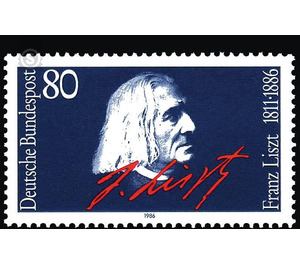100th anniversary of death of Franz Liszt - Germany / Federal Republic of Germany 1986 - 80 Pfennig
Theme: Art & Culture
| Country | Germany / Federal Republic of Germany |
| Issue Date | 1986 |
| Face Value | 80.00 |
| Color | violet |
| Perforation | K 14 |
| Printing Type | 3-color offset |
| Stamp Type | Postage stamp |
| Item Type | Stamp |
| Chronological Issue Number | 1158 |
| Chronological Chapter | GER-BRD |
| Michel ID | BRD 1285 |
| SID | 75401 |
| In 51 Wishlists | |
On July 31, 1886, Franz Liszt died in Bayreuth. Even in his old age he had participated in the Bayreuth Festival, the legacy of his former friend Richard Wagner, who after Wagner's death was led by his wife Cosima, Liszt's daughter. Liszt's tomb in Bayreuth, for instance, commemorates Liszt's commitment to Wagner's work all his life, but it does not bear witness to the work of the distinguished musician, the cosmopolitan with cities such as Vienna, Paris, Geneva, Weimar, Rome and Budapest combines. Franz Liszt was born on October 22, 1811 in Raiding (Burgenland). His extraordinary pianistic talent was discovered early, in 1822 he received instruction in Vienna from Carl Czerny, the pupil and friend of Ludwig van Beethoven. According to an unasserted story, Czerny is said to have persuaded Beethoven, already deaf at the time, to attend a concert by the young piano genius, at the end of which Beethoven kissed Liszt on the forehead. The hopes that were put in the child prodigy should be fulfilled to an unimaginable degree. In Paris Liszt became the first pianist of his time. His model was Niccolò Paganini, what this meant for the violin playing, Liszt wanted to achieve with the piano. A masterpiece in this way was the transmission of the Symphonie fantastique by Hector Berlioz, the admired composer who knew how to use the sound colors of the orchestra so instrumentally technically, on the seemingly so tonally colored piano (1833). It began the legendary virtuoso time. Liszt gave concerts all over Europe, and his performances have always been triumphs. Even strict critics and competitors could not deny Liszt the recognition, but the public adored him, they spoke of "Lisztomania," which spread like a plague. The many stories that deal with Liszt's relationship with women date from this period. Even his years together with the Comtesse Marie d'Agoult, who sprouted three children (the second was Cosima), became a legend. It goes without saying that Liszt's unanimous and extremely charming and enchanting personality, together with his artistic talents, gave rise to a flamboyance on the part of femininity, which almost invited gossip. Another woman, Marie d'Agoult, who was appropriately married, lived for several years with Liszt, Princess Carolyne of Sayn-Wittgenstein. She became the accompanist of his composer career. In 1848, in the midst of his greatest successes, Liszt suddenly gave up concertation and went to Weimar as court music director. However, Liszt had prepared this step according to plan. The virtuoso existence was not enough for him, he now wanted to realize his compositional ideas. Weimar's election was a homage to German idealism, which was to be reborn. How aware Liszt was of his intentions is proved by the fact that he, who had hitherto composed some piano works but hardly any orchestral music, has in a few years created a compositional work of considerable scope. The Symphonic Poems (including Les Preludes), the Faust Symphony, the Two Piano Concertos, the Graner Festmesse and many other works by Liszt date back to 1861, Liszt also developed a diverse artistic activity, attended by almost every major musician and pianist of his time him at the Altenburg in Weimar, where he maintained a very unique style of teaching in the style of a salon. The "New German School" that he formed here was one of the most important musical and aesthetic movements of the 19th century. Liszt's life and work can be divided into three periods: the virtuoso career until 1848, the Weimar period of the great instrumental works until 1861, and finally the period of church music reform efforts. Liszt now lived in Rome, since 1871 Weimar and Budapest as residences, which he regularly visited, added. He composed great oratorios: "St. Elizabeth" and "Christ" as well as numerous other sacred works. However, his compositional style increasingly met with incomprehension; Liszt's late works were recognized as pioneering works of Impressionism and New Music only in our century. In fact, the fame of the virtuoso pianist has up to this day obscured the importance of the composer. Among the honors of the life's work of Franz Liszt the inclusion in the medal "Pour le mérite" (31 May 1842) certainly has a very special meaning. The portrait of Liszt on the stamp, an early example of portrait photography, shows him in late times. His five warts were known, of which only one can be seen here. It can be seen from the collar that Liszt wears a cassock, the clothing of Catholic clergymen. Since he had received the consecrations as Abbé in Rome, this outward sign of religious commitment was his preferred clothing. (Text: Dr. Helmut Loos, Musicology Seminar of the Rheinische Friedrich-Wilhelms-University, Bonn)
| Condition | Name | In Stock | Price | Price + Shipping | Store | |
|---|---|---|---|---|---|---|
 | Unmounted Mint ** | 100th anniversary of death of Franz Liszt - Germany / Federal Republic of Germany 1986 - 80 Pfennig | 10 | US $1.09 | US $4.34 |  FILATELIELOKET (0) FILATELIELOKET (0)Shipping US $3.25 Minimum Order US $2.72 |


